Effects of a Soluble Guanylate Cyclase Stimulator Riociguat on Contractility of Isolated Pulmonary Artery and Hemodynamics of U46619-Induced Pulmonary Hypertension in Dogs
Abstract
Simple Summary
Abstract
1. Introduction
2. Materials and Methods
2.1. Animals
2.2. Drugs
2.3. Measurement of Isometric Contraction of Isolated PA
2.4. Measurement of cGMP Contents
2.5. Anesthesia
2.6. Invasive Hemodynamic Evaluation
2.7. Study Protocol
2.8. Statistical Analysis
3. Results
3.1. Effect of Riociguat on ET-1-Induced Contraction of Isolated Canine PA
3.2. Effect of Riociguat on cGMP Content in Isolated Canine PA
3.3. Effects of Riociguat on Elevated PAP in U46619-Induced Acute PH Model Dog
3.4. Effects of Riociguat on SAP in U46619-Induced Acute PH Model Dog
3.5. Effects of Riociguat on CO in U46619-Induced Acute PH Model Dog
4. Discussion
5. Conclusions
Author Contributions
Funding
Institutional Review Board Statement
Informed Consent Statement
Data Availability Statement
Acknowledgments
Conflicts of Interest
References
- Deng, J. Clinical Application of Pulmonary Vascular Resistance in Patients with Pulmonary Arterial Hypertension. J. Cardiothorac. Surg. 2021, 16, 311. [Google Scholar] [CrossRef] [PubMed]
- Al-Omary, M.S.; Sugito, S.; Boyle, A.J.; Sverdlov, A.L.; Collins, N.J. Pulmonary Hypertension Due to Left Heart Disease: Diagnosis, Pathophysiology, and Therapy. Hypertension 2020, 75, 1397–1408. [Google Scholar] [CrossRef] [PubMed]
- Rosenzweig, E.B.; Krishnan, U. Congenital Heart Disease-Associated Pulmonary Hypertension. Clin. Chest Med. 2021, 42, 9–18. [Google Scholar] [CrossRef]
- Reinero, C.; Visser, L.C.; Kellihan, H.B.; Masseau, I.; Rozanski, E.; Clercx, C.; Williams, K.; Abbott, J.; Borgarelli, M.; Scansen, B.A. ACVIM Consensus Statement Guidelines for the Diagnosis, Classification, Treatment, and Monitoring of Pulmonary Hypertension in Dogs. J. Vet. Intern. Med. 2020, 34, 549–573. [Google Scholar] [CrossRef] [PubMed]
- Glaus, T.M.; Soldati, G.; Maurer, R.; Ehrensperger, F. Clinical and Pathological Characterisation of Primary Pulmonary Hypertension in a Dog. Vet. Rec. 2004, 154, 786–789. [Google Scholar] [CrossRef]
- Rawlings, C.A.; Farrell, R.L.; Mahood, R.M. Morphologic Changes in the Lungs of Cats Experimentally Infected with Dirofilaria Immitis. Response to Aspirin. J. Vet. Intern. Med. 1990, 4, 292–300. [Google Scholar] [CrossRef]
- Ray, L.; Mathieu, M.; Jespers, P.; Hadad, I.; Mahmoudabady, M.; Pensis, A.; Motte, S.; Peters, I.R.; Naeije, R.; McEntee, K. Early Increase in Pulmonary Vascular Reactivity with Overexpression of Endothelin-1 and Vascular Endothelial Growth Factor in Canine Experimental Heart Failure. Exp. Physiol. 2008, 93, 434–442. [Google Scholar] [CrossRef] [PubMed]
- Pulido, T.; Zayas, N.; de Mendieta, M.A.; Plascencia, K.; Escobar, J. Medical Therapies for Pulmonary Arterial Hypertension. Heart Fail. Rev. 2016, 21, 273–283. [Google Scholar] [CrossRef]
- Zhao, Y.; Vanhoutte, P.M.; Leung, S.W.S. Vascular Nitric Oxide: Beyond ENOS. J. Pharmacol. Sci. 2015, 129, 83–94. [Google Scholar] [CrossRef]
- Cohen, A.H.; Hanson, K.; Morris, K.; Fouty, B.; McMurtry, I.F.; Clarke, W.; Rodman, D.M. Inhibition of Cyclic 3′-5′-Guanosine Monophosphate-Specific Phosphodiesterase Selectively Vasodilates the Pulmonary Circulation in Chronically Hypoxic Rats. J. Clin. Investig. 1996, 97, 172–179. [Google Scholar] [CrossRef]
- Yamamoto, T.; Wada, A.; Tsutamoto, T.; Ohnishi, M.; Horie, M. Long-Term Treatment with a Phosphodiesterase Type 5 Inhibitor Improves Pulmonary Hypertension Secondary to Heart Failure through Enhancing the Natriuretic Peptides-CGMP Pathway. J. Cardiovasc. Pharmacol. 2004, 44, 596–600. [Google Scholar] [CrossRef] [PubMed]
- Fullerton, D.A.; Mitchell, M.B.; Jones, D.N.; Maki, A.; McIntyre, R.C. Pulmonary Vasomotor Dysfunction Is Produced with Chronically High Pulmonary Blood Flow. J. Thorac. Cardiovasc. Surg. 1996, 111, 190–197. [Google Scholar] [CrossRef] [PubMed]
- Kurakula, K.; Smolders, V.F.E.D.; Tura-Ceide, O.; Wouter Jukema, J.; Quax, P.H.A.; Goumans, M.J. Endothelial Dysfunction in Pulmonary Hypertension: Cause or Consequence? Biomedicines 2021, 9, 57. [Google Scholar] [CrossRef] [PubMed]
- Giaid, A.; Saleh, D. Reduced Expression of Endothelial Nitric Oxide Synthase in the Lungs of Patients with Pulmonary Hypertension. N. Engl. J. Med. 1995, 333, 214–221. [Google Scholar] [CrossRef]
- Johnson, L.R.; Stern, J.A. Clinical Features and Outcome in 25 Dogs with Respiratory-Associated Pulmonary Hypertension Treated with Sildenafil. J. Vet. Intern. Med. 2020, 34, 65–73. [Google Scholar] [CrossRef]
- Kellum, H.B.; Stepien, R.L. Sildenafil Citrate Therapy in 22 Dogs with Pulmonary Hypertension. J. Vet. Intern. Med. 2007, 21, 1258–1264. [Google Scholar] [CrossRef]
- Schermuly, R.T.; Stasch, J.P.; Pullamsetti, S.S.; Middendorff, R.; Müller, D.; Schlüter, K.D.; Dingendorf, A.; Hackemack, S.; Kolosionek, E.; Kaulen, C.; et al. Expression and Function of Soluble Guanylate Cyclase in Pulmonary Arterial Hypertension. Eur. Respir. J. 2008, 32, 881–891. [Google Scholar] [CrossRef]
- Næsheim, T.; How, O.J.; Myrmel, T. Hemodynamic Effects of a Soluble Guanylate Cyclase Stimulator, Riociguat, and an Activator, Cinaciguat, During NO-Modulation in Healthy Pigs. J. Cardiovasc. Pharmacol. Ther. 2021, 26, 75–87. [Google Scholar] [CrossRef]
- Gong, F.; Shiraishi, H.; Kikuchi, Y.; Hoshina, M.; Ichihashi, K.; Sato, Y.; Momoi, M.Y. Inhalation of Nebulized Nitroglycerin in Dogs with Experimental Pulmonary Hypertension Induced by U46619. Pediatr. Int. 2000, 42, 255–258. [Google Scholar] [CrossRef]
- Hori, Y.; Kondo, C.; Matsui, M.; Yamagishi, M.; Okano, S.; Chikazawa, S.; Kanai, K.; Hoshi, F.; Itoh, N. Effect of the Phosphodiesterase Type 5 Inhibitor Tadalafil on Pulmonary Hemodynamics in a Canine Model of Pulmonary Hypertension. Vet. J. 2014, 202, 334–339. [Google Scholar] [CrossRef]
- Freitas, C.F.; Morganti, R.P.; Annichino-Bizzacchi, J.M.; De Nucci, G.; Antunes, E. Effect of BAY 41-2272 in the Pulmonary Hypertension Induced by Heparin-Protamine Complex in Anaesthetized Dogs. Clin. Exp. Pharmacol. Physiol. 2007, 34, 10–14. [Google Scholar] [CrossRef] [PubMed]
- Ricco Pereira, C. Body Surface Area Calculation for Dogs and Cats Using LiDCO and PICCO Monitors. J. Vet. Emerg. Crit. Care 2020, 30, 498–500. [Google Scholar] [CrossRef] [PubMed]
- Fukumoto, S.; Hanazono, K.; Miyasho, T.; Endo, Y.; Kadosawa, T.; Iwano, H.; Uchide, T. Serum Big Endothelin-1 as a Clinical Marker for Cardiopulmonary and Neoplastic Diseases in Dogs. Life Sci. 2014, 118, 329–332. [Google Scholar] [CrossRef] [PubMed]
- Qingyan, Z.; Xuejun, J.; Yanhong, T.; Zixuan, D.; Xiaozhan, W.; Xule, W.; Zongwen, G.; Wei, H.; Shengbo, Y.; Congxin, H. Beneficial Effects of Renal Denervation on Pulmonary Vascular Remodeling in Experimental Pulmonary Artery Hypertension. Rev. Esp. Cardiol. (Engl. Ed.) 2015, 68, 562–570. [Google Scholar] [CrossRef] [PubMed]
- Kwak, Y.L.; Jones, K.A.; Warner, D.O.; Perkins, W.J. Prolonged Relaxation Consistent with Persistent Soluble Guanylyl Cyclase Activation in Canine Pulmonary Artery Following Brief Treatment with Nitric Oxide Donors. Life Sci. 2006, 79, 2001–2009. [Google Scholar] [CrossRef]
- Morita, K.; Ogawa, Y.; Tobise, K. Effect of Endothelium of Pulmonary Artery Vasoreactivity in Monocrotaline-Induced Pulmonary Hypertensive Rats. Jpn. Circ. J. 1996, 60, 585–592. [Google Scholar] [CrossRef]
- Murata, M.; Kawakami, T.; Kataoka, M.; Moriyama, H.; Hiraide, T.; Kimura, M.; Endo, J.; Kohno, T.; Itabashi, Y.; Fukuda, K. Clinical Significance of Guanylate Cyclase Stimulator, Riociguat, on Right Ventricular Functional Improvement in Patients with Pulmonary Hypertension. Cardiology 2021, 146, 130–136. [Google Scholar] [CrossRef]
- Rai, N.; Veeroju, S.; Schymura, Y.; Janssen, W.; Wietelmann, A.; Kojonazarov, B.; Weissmann, N.; Stasch, J.P.; Ghofrani, H.A.; Seeger, W.; et al. Effect of Riociguat and Sildenafil on Right Heart Remodeling and Function in Pressure Overload Induced Model of Pulmonary Arterial Banding. Biomed. Res. Int. 2018, 2018, 3293584. [Google Scholar]
- Magder, S. The Meaning of Blood Pressure. Crit. Care 2018, 22, 257. [Google Scholar] [CrossRef]
- Jahr, J.S.; Lurie, F.; Bezdikian, V.; Driessen, B.; Gunther, R.A. Measuring Circulating Blood Volume Using Infused Hemoglobin-Based Oxygen Carrier (Oxyglobin) as an Indicator: Verification in a Canine Hypovolemia Model. Am. J. Ther. 2008, 15, 98–101. [Google Scholar] [CrossRef]
- Frey, R.; Becker, C.; Saleh, S.; Unger, S.; van der Mey, D.; Mück, W. Clinical Pharmacokinetic and Pharmacodynamic Profile of Riociguat. Clin. Pharmacokinet. 2018, 57, 647–661. [Google Scholar] [CrossRef] [PubMed]
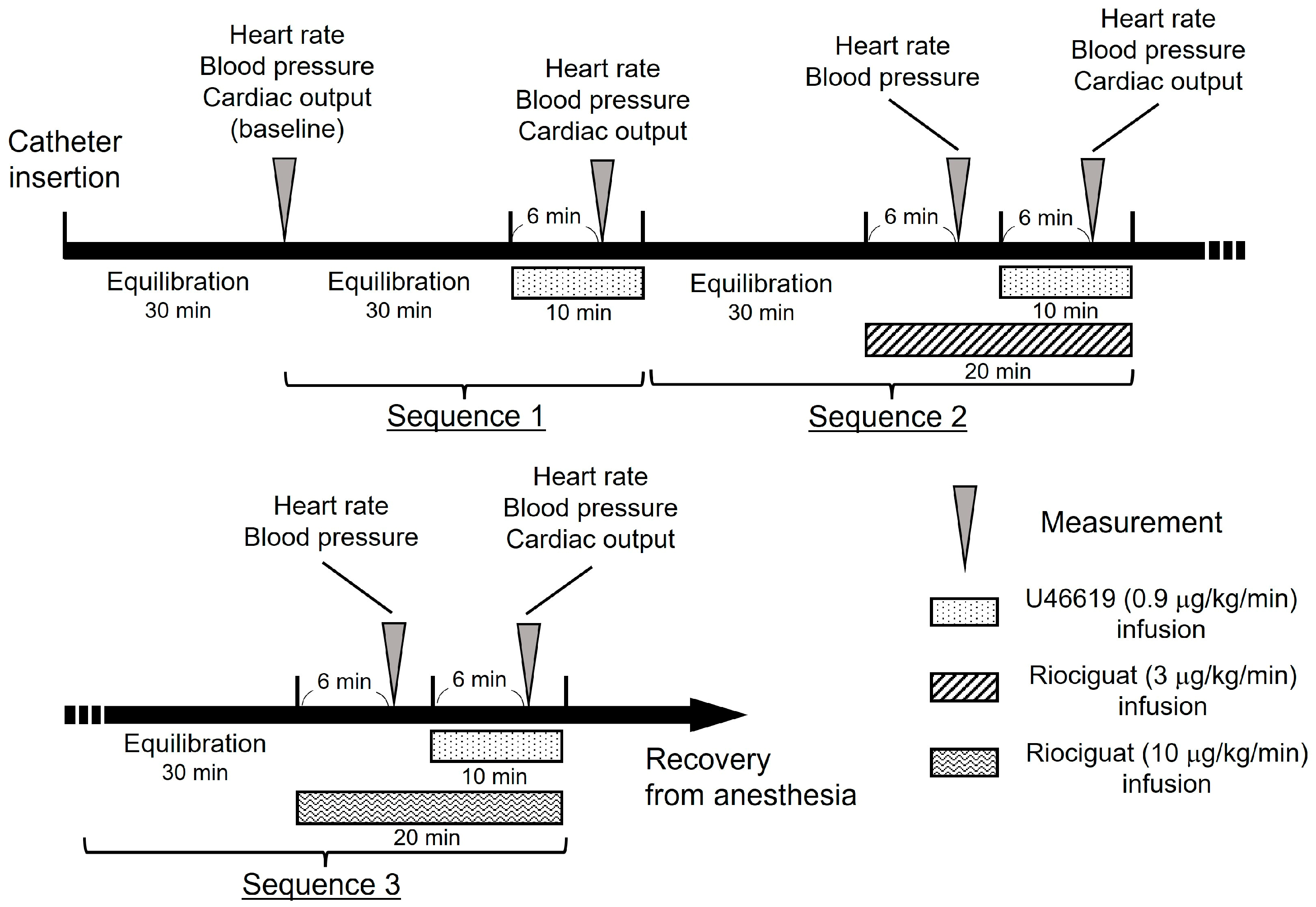
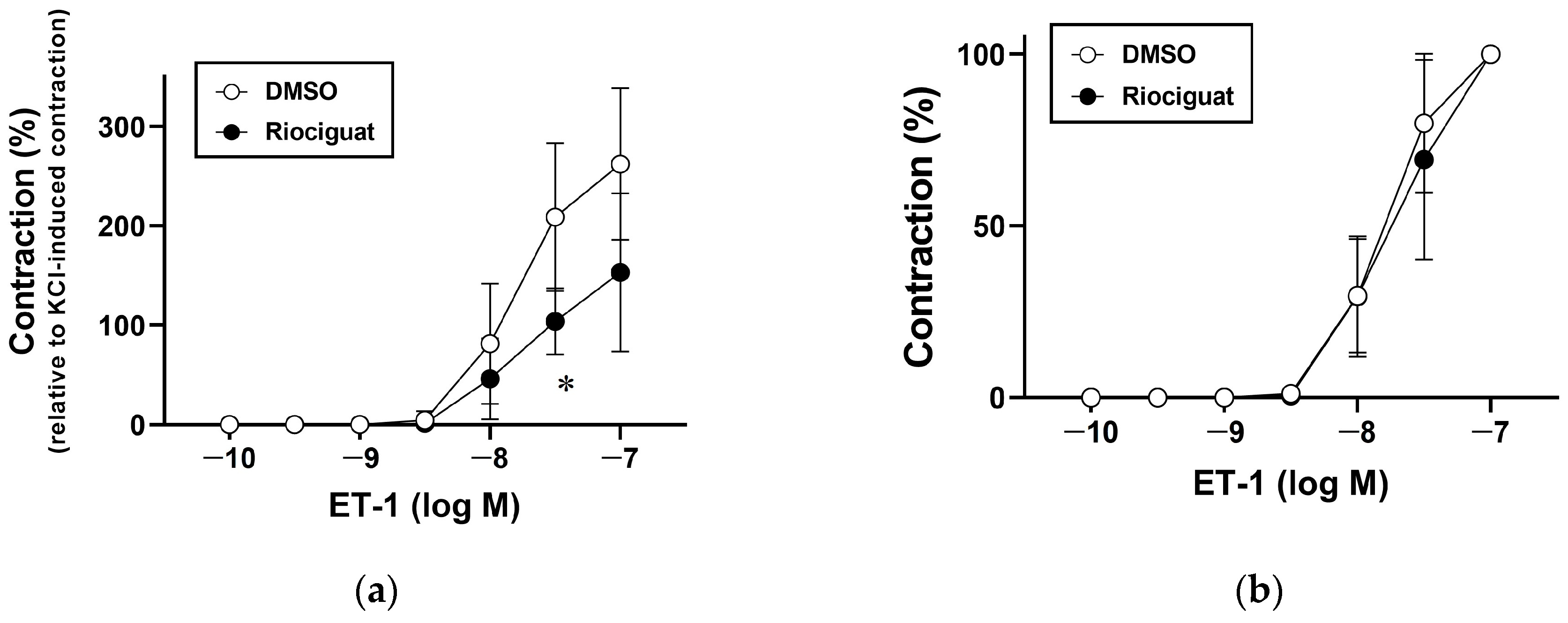
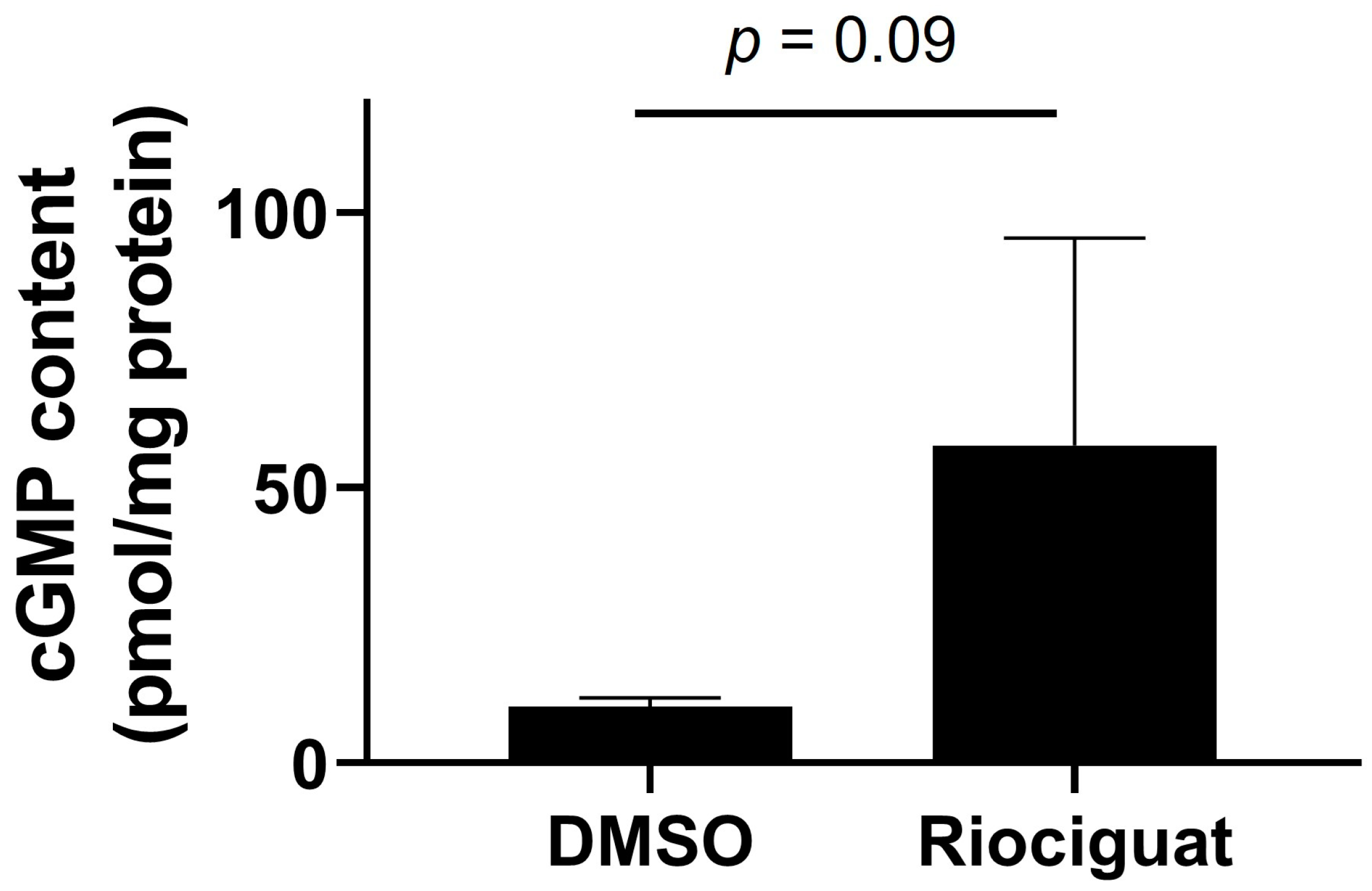
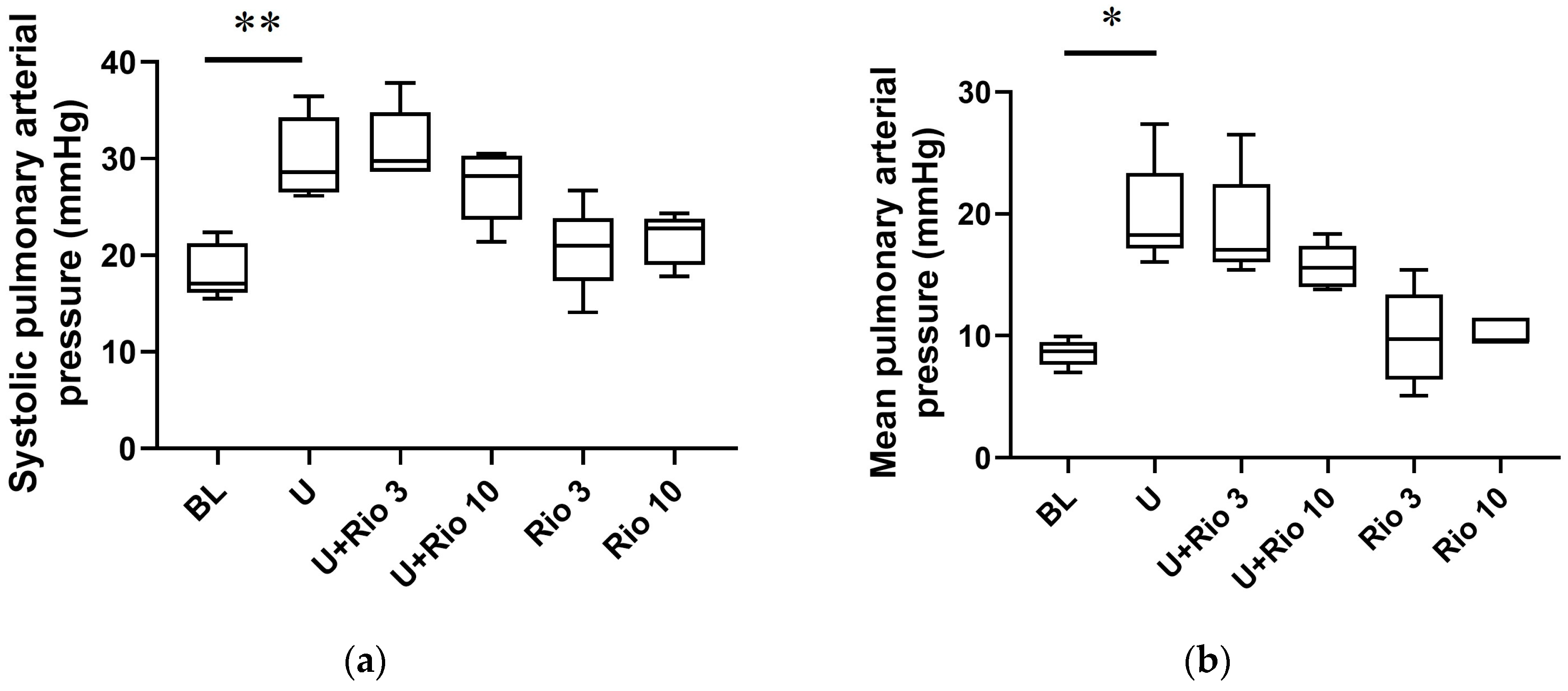
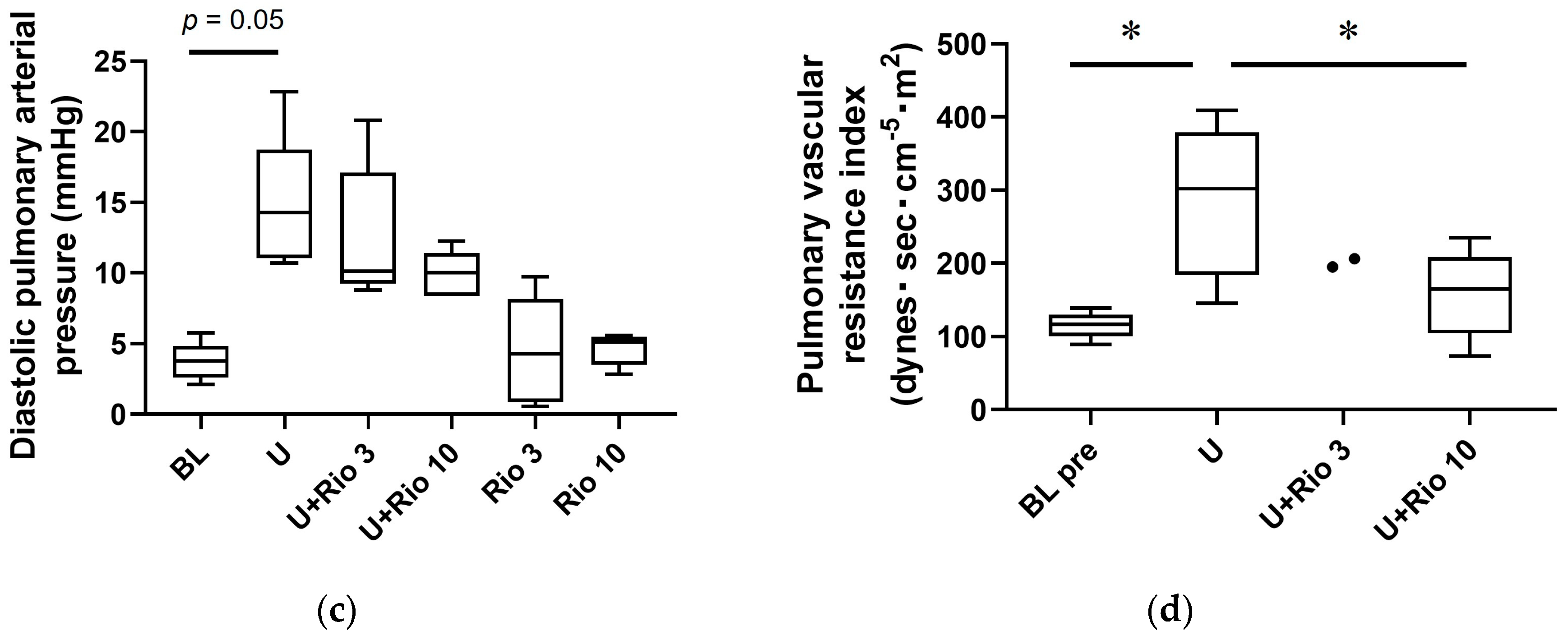
| Baseline | U | U + Rio 3 | U + Rio 10 | Rio 3 | Rio 10 | |
|---|---|---|---|---|---|---|
| HR (bpm) | 114.0 ± 11.8 (n = 5) | 119.0 ± 18.2 (n = 5) | 132.8 ± 24.8 (n = 5) | 138.0 ± 19.2 (n = 5) | 139.2 ± 30.5 (n = 5) | 134.0 ± 23.8 (n = 5) |
| sPAP (mmHg) | 18.3 ± 2.8 (n = 5) | 30.0 ± 4.3 ** (n = 5) | 31.3 ± 3.8 (n = 5) | 27.2 ± 3.7 (n = 5) | 20.7 ± 4.5 (n = 5) | 21.7 ± 2.6 (n = 5) |
| mPAP (mmHg) | 8.6 ± 1.1 (n = 5) | 19.9 ± 4.4 * (n = 5) | 18.8 ± 4.4 (n = 5) | 15.7 ± 1.8 (n = 5) | 9.9 ± 3.9 (n = 5) | 10.3 ± 1.1 (n = 5) |
| dPAP (mmHg) | 3.7 ± 1.3 (n = 5) | 14.8 ± 4.8 (n = 5) | 12.6 ± 4.9 (n = 5) | 9.9 ± 1.6 (n = 5) | 4.5 ± 3.8 (n = 5) | 4.6 ± 1.1 (n = 5) |
| sSAP (mmHg) | 88.2 ± 10.0 (n = 5) | 101.8 ± 12.9 * (n = 5) | 96.8 ± 8.1 (n = 5) | 95.8 ± 8.0 (n = 5) | 90.4 ± 12.0 (n = 5) | 90.6 ± 10.6 (n = 5) |
| mSAP (mmHg) | 74.4 ± 10.8 (n = 5) | 86.2 ± 15.1 (n = 5) | 80.2 ± 8.1 (n = 5) | 81.0 ± 8.7 (n = 5) | 76.2 ± 13.4 (n = 5) | 75.2 ± 11.7 (n = 5) |
| dSAP (mmHg) | 62.8 ± 9.7 (n = 5) | 74.8 ± 12.4 (n = 5) | 66.2 ± 8.4 (n = 5) | 66.6 ± 8.4 (n = 5) | 61.2 ± 12.3 (n = 5) | 61.6 ± 11.1 (n = 5) |
| mPAWP (mmHg) | 1.6 ± 0.8 (n = 5) | 4.2 ± 1.7 (n = 5) | 3.5 ± 2.8 (n = 4) | 3.5 ± 1.1 (n = 5) | 1.4 ± 1.5 (n = 5) | 2.1 ± 1.5 (n = 5) |
| mCVP (mmHg) | 0.5 ± 1.0 (n = 5) | 2.8 ± 1.9 (n = 5) | 3.0 ± 2.0 (n = 5) | 1.3 ± 1.0 (n = 5) | −0.6 ± 2.4 (n = 5) | 0.2 ± 1.4 (n = 5) |
| CO (L/min) | 2.4 ± 0.6 (n = 5) | 2.3 ± 0.9 (n = 5) | 2.9 ± 0.7 (n = 3) | 3.5 ± 1.8 (n = 5) | - | - |
| PVR index (dynes·s·cm−5·m2) | 115.8 ± 18.1 (n = 5) | 285.6 ± 103.8 * (n = 5) | 200.9 ± 7.8 (n = 2) | 158.3 ± 59.7 # (n = 5) | - | - |
| SVR index (dynes·s·cm−5·m2) | 1228.2 ± 190.5 (n = 5) | 1559.7 ± 657.2 (n = 5) | 1054.0 ± 331.2 (n = 3) | 1016.2 ± 294.5 (n = 5) | - | - |
Disclaimer/Publisher’s Note: The statements, opinions and data contained in all publications are solely those of the individual author(s) and contributor(s) and not of MDPI and/or the editor(s). MDPI and/or the editor(s) disclaim responsibility for any injury to people or property resulting from any ideas, methods, instructions or products referred to in the content. |
© 2023 by the authors. Licensee MDPI, Basel, Switzerland. This article is an open access article distributed under the terms and conditions of the Creative Commons Attribution (CC BY) license (https://creativecommons.org/licenses/by/4.0/).
Share and Cite
Kameshima, S.; Nakamura, Y.; Uehara, K.; Kodama, T.; Yamawaki, H.; Nishi, K.; Okano, S.; Niijima, R.; Kimura, Y.; Itoh, N. Effects of a Soluble Guanylate Cyclase Stimulator Riociguat on Contractility of Isolated Pulmonary Artery and Hemodynamics of U46619-Induced Pulmonary Hypertension in Dogs. Vet. Sci. 2023, 10, 159. https://doi.org/10.3390/vetsci10020159
Kameshima S, Nakamura Y, Uehara K, Kodama T, Yamawaki H, Nishi K, Okano S, Niijima R, Kimura Y, Itoh N. Effects of a Soluble Guanylate Cyclase Stimulator Riociguat on Contractility of Isolated Pulmonary Artery and Hemodynamics of U46619-Induced Pulmonary Hypertension in Dogs. Veterinary Sciences. 2023; 10(2):159. https://doi.org/10.3390/vetsci10020159
Chicago/Turabian StyleKameshima, Satoshi, Yuki Nakamura, Kenji Uehara, Tomoko Kodama, Hideyuki Yamawaki, Kotaro Nishi, Shozo Okano, Ryo Niijima, Yuya Kimura, and Naoyuki Itoh. 2023. "Effects of a Soluble Guanylate Cyclase Stimulator Riociguat on Contractility of Isolated Pulmonary Artery and Hemodynamics of U46619-Induced Pulmonary Hypertension in Dogs" Veterinary Sciences 10, no. 2: 159. https://doi.org/10.3390/vetsci10020159
APA StyleKameshima, S., Nakamura, Y., Uehara, K., Kodama, T., Yamawaki, H., Nishi, K., Okano, S., Niijima, R., Kimura, Y., & Itoh, N. (2023). Effects of a Soluble Guanylate Cyclase Stimulator Riociguat on Contractility of Isolated Pulmonary Artery and Hemodynamics of U46619-Induced Pulmonary Hypertension in Dogs. Veterinary Sciences, 10(2), 159. https://doi.org/10.3390/vetsci10020159





